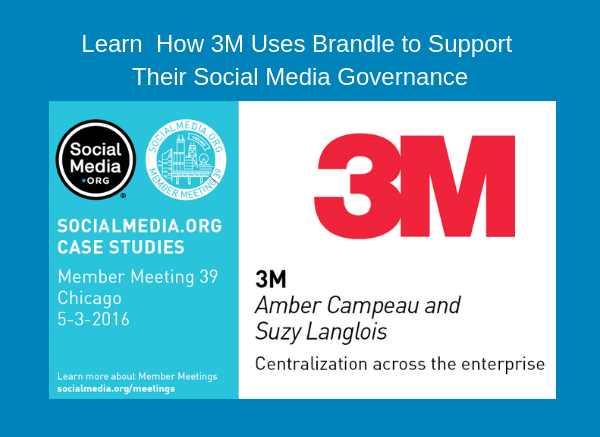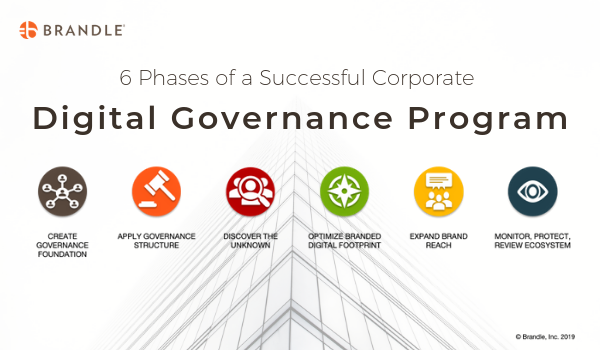
At Brandle, we spend a lot of time guiding corporations on how to create a successful social media and digital governance plan. However, for real governance success, it is essential to prepare a digital governance foundation. Creating this foundation is the way to ensure executive support and global adherence to the plan! And working the plan is how the corporation can strengthen its digital brand reputation and reduce risks that may threaten brand health. While each company faces unique challenges in regard to digital governance and compliance, we see the greatest success with companies who first, prepare the groundwork, second, centralize governance, and third, introduce a corporate digital governance plan.
This post will take you through the five elements to prepare the groundwork for a successful digital governance plan and program!
Prepare the Digital Governance Groundwork
It's easy to say "prepare the groundwork", and difficult to accomplish. But like most things that have "governance" and "risk" attached to them, the power is in the details and the effort is rewarded. Performing thorough research and work during the groundwork phase is what makes corporate digital governance much more successful. So here are the first five "groundwork" projects to lay down your powerful governance foundation!
1. Align Digital Governance with Corporate Structure.
In general, companies should strive to align their digital governance with their corporate structure. This includes considering how the plan will affect different business units, regions, brand and corporate marketing, sales, and customer support. This is also the time to determine how you will gain buy-in from each department head to support the digital governance structure. Governance leads may want to ask themselves whether they should align their governance with:
- Business Units or Divisions
- Regions, Countries or Territories
- Corporate Marketing or Brand Marketing (by Brand)
Additionally, it is important to know how you will need to include other corporate groups that may be engaged with brand, sales or support channels on social media. These include:
- Sales
- Customer Support
- Partner Programs
- Influencer Programs
Knowing who needs to be involved and who needs to be governed (and monitored) allows you to clearly see how you need to get management buy-in for long term support. You do need an executive champion for this program to work, but you also need other management support. Think of it this way: if you need the cooperation of a peer in a different country to adopt the corporate governance plan, why should they support the plan if their superior has not made it part of their job responsibility (and therefore part of their performance requirement)? Strong digital governance and cyber risk management requires a corporate-wide approach.
2. Appoint the Governance Team and Stakeholders
If digital governance is in the works, then there is likely an executive champion and team lead in place. The champion is often the CMO, but we've also seen the role assigned to the Chief Risk Officer and occasionally the CEO takes on the champion role. The team lead is usually someone that is assigned as "Global Digital/Social Media Governance Lead". Based on the decision made in step one, the CMO and governance lead set about designing a global, cross-functional team to lead governance for the company. Each team member has a role in taking governance requirements back to their department, country, or division.
While assembling the team, it is also important to determine how the team will communicate, when they will meet, and how they will come together in a crisis scenario.
3. Assess Risks
The governance team then accurately assesses the risks to the company and how they might play out digitally. Cyber risks are certainly part of this, but general risks are also important. For instance, the team may want to determine risks such as how a natural disaster or stock market crash would influence their social media strategy. All corporate risks should be considered, and if/how the digital landscape (website, social media, emails, etc.) would be used to address a risk scenario (and to whom). If the crises was actually due to a cyber attack, then that event would have a different plan.
Finally, the team will want to assess what tools are needed to attach to social media accounts (in each department and around the world) to determine the threat vector through branded social media channels. This is a good time to analyze whether streamlining your tools (social media, marketing, support and sales stack) to corporate standards is important.
4. Analyze Successes, Failures, and Note Changes
If the company has utilized some form of digital governance in the past, the team will also want to review the successes and failures of the previous model. These should highlight governance successes and failures and not marketing successes and failures. For example, if a crisis occurred in the past year, you will want to analyze the speed in which the company acted across departments, if the action was pre-planned and activated quickly, and if the result was satisfactory. If the crisis management was handled well, you will want to utilize the model in your digital governance plan for the coming year; if it was not successful, note the reasons why and create the action item to improve crisis management procedures for the new digital governance plan.
Be sure to list successes and failures and whether you would like to migrate the model to the new governance plan or make changes to improve a process. It may be interesting to review successes and failures by platform (perhaps the crisis plan worked great on Twitter but not on Facebook ...why?
5. Perform Social Network Analysis and Risk Reviews
After the corporate risk assessment, and past governance successes and failures are reviewed, it's time to conduct a deep dive analysis of the social networks technology. The networks can change rapidly and it's worth the time to review what has changed in the past year including:
- Options to pages or accounts (what has been added and what has been taken away). This past year, Facebook made a lot of changes. Do you know what they are?
- License agreement, privacy policy, rules for engagement, data use by the network
- API, API access
- New opportunities such as new page types, communities, and access to markets.
- Demographics of current installed base and active user percent.
It is also important to review if the network itself had any crises or cyber attacks. If the answer is yes, you may want to consider your use of the network moving forward, especially if it is not a priority network for the company.
In the next post, we will address the second and third steps to lay a solid digital governance foundation: What functions reside in a central governance team and the key items needed in a digital governance plan.
Final Thoughts
Here at Brandle, we understand that it can be challenging for large corporations to make the changes necessary to implement a proper digital governance foundation. However, without this foundation in place, every subsequent action taken to promote digital governance and compliance could be undermined. Contact our team here to learn how we can help you with your governance strategy and provide you with the SaaS tools necessary to manage your governance program.








